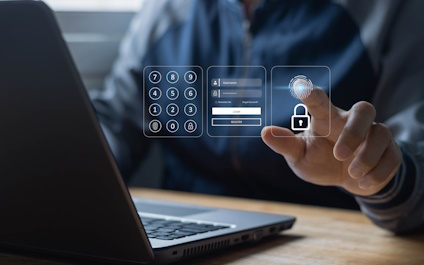Celebrated on every first Thursday in May, World Password Day encourages us to re-evaluate our current password practices and potentially consider other, additional forms of cybersecurity. With online threats on the rise, keeping your data locked behind simple authentication codes may no longer cut it.
Fortunately, biometrics offers a promising alternative. Ditching the use of text-based verification, this cybersecurity method offers a much more robust, user-friendly way of securing your private information. In this article, we break down its key differences from traditional passwords.
What is biometric authentication?
Biometric authentication verifies a user’s identity through their unique physical and behavioral characteristics, such as fingerprints, iris patterns, facial features, and voice tones, among others. Users will provide this biometric data when accessing a system or device, which is then compared to previously recorded data to confirm their identity. If the data matches, access is granted.
The benefits of biometrics
As a more advanced form of cybersecurity, biometric authentication offers plenty of advantages over passwords, including:
Being unique and difficult to replicate
Unlike passwords, which can be forgotten, stolen, or guessed, biometric data is tied directly to an individual and is much more challenging for unauthorized users to mimic. For example, fingerprints or facial features are distinct to each person, making it difficult for others to replicate them accurately.
This reduces the risk of unauthorized access because even if someone learns your password, they can’t access your device or system without your specific biometric data, thus adding an extra layer of protection. Additionally, most biometrics now include a “liveness” assessment, preventing hackers from using masks or photographs to try and bypass facial recognition.
Greater convenience and user experience
With biometric authentication, users don’t need to memorize complex passwords, relieving the burden of remembering and managing multiple login credentials. Instead, they simply need to provide their unique physical or behavioral traits, such as through fingerprint scans or voice recognition. This streamlined process saves plenty of time and makes the user experience much more efficient and seamless.
Moreover, biometrics remove the need to regularly change or update passwords, reducing the likelihood of relying on overly simple codes or reusing old ones out of convenience. They also prevent you from saving your passwords on your system or device itself, making them easy for online third parties to steal.
Improved security
Traditional phishing attacks aim to trick users into revealing their passwords or other sensitive information through deceptive email messages or websites. By not relying on passwords or online codes, however, biometrics are immune to these tactics. Their reliance on an individual’s unique characteristics also mitigates the risk of falling victim to common social engineering scams.
On top of that, biometric authentication renders brute force attacks ineffective. Hackers will often use password-cracking tools or dictionary attacks to try and guess their way into a user’s system, though the complexity of biometrics, especially when paired with multifactor authentication, creates a barrier against these attacks.
The pitfalls of biometrics
Biometric authentication is by no means a foolproof security method, however. It’s important to be wary of the following potential downsides:
- Privacy concerns: Biometric data, once compromised, cannot be changed like passwords. There are concerns about the storage and potential misuse of biometric data, including the risk of identity theft.
- Accuracy and reliability: Biometric systems may sometimes produce false negatives or positives, leading to authentication errors. For example, environmental conditions, injuries, or even aging can affect the accuracy of biometric scans.
- Cost and implementation: Deploying biometric authentication systems can be expensive, as it often requires specialized hardware and software. Additionally, integrating biometrics into existing systems may pose logistical challenges that require significant investment.
Ultimately, choosing between biometrics or traditional passwords will depend on factors such as your security needs, user convenience, privacy concerns, and deployment considerations. Before making the move, take the time to evaluate your unique business requirements and the specific risks and financial investments these new systems may pose.
Seeking to enhance your cybersecurity measures? Our experts at NetQuest can help guide you through the best security tools and solutions in Baltimore, with strategies tailor-made to your business needs. Keep hackers at bay — get in touch with us today.



